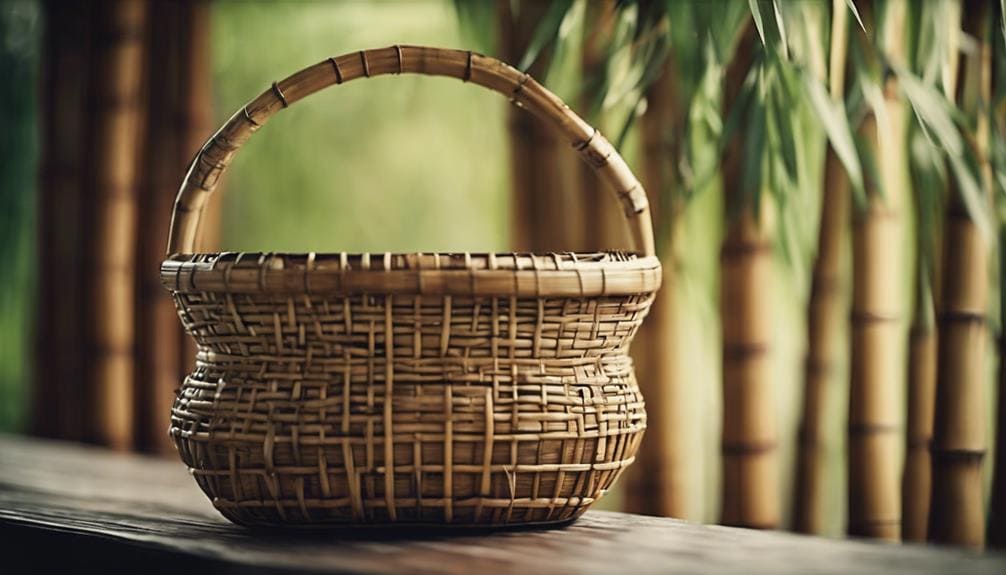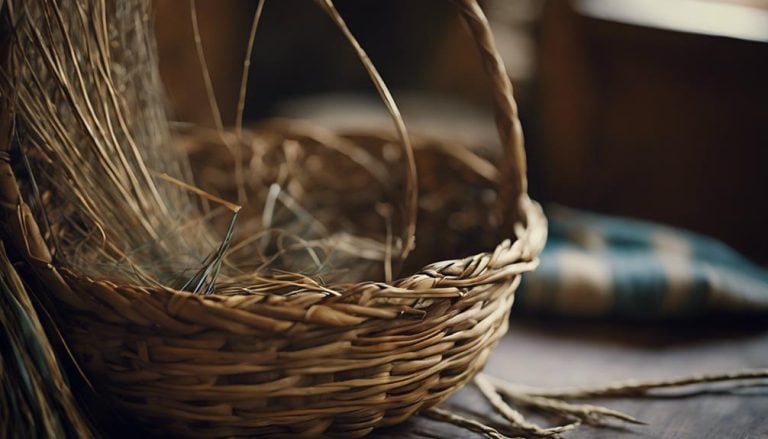Traditional Materials for Basket Making
When exploring the world of basketry, one quickly realizes the importance of traditional materials. Deeply rooted in history and culture, these natural fibers are crucial to the craft’s authenticity and sustainability.
However, what truly sets these materials apart and makes them indispensable in basket making is their ability to withstand the test of time and offer a unique blend of functionality and aesthetics. Their significance goes beyond mere practicality, hinting at a deeper connection to nature and the art of weaving itself.
Traditional materials for basket-making include natural fibers such as grasses, reeds, and vines. These materials are woven together to create functional and decorative baskets.
Key Takeaways
- Willow, bamboo, rattan, and reed offer strength, flexibility, and diverse design possibilities.
- Leather adds elegance and durability to traditional baskets.
- Utilizing invasive plants like Morning Glory Vines can create unique basket designs.
- Testing material suitability ensures functional and long-lasting baskets.
Willow and Its Significance
With its remarkable flexibility and strength, Willow is a cornerstone material in basket making, cherished for its intricate weaving capabilities and abundant availability. Its natural beauty shines through in the way it effortlessly bends and curves, allowing artisans to create intricate and artistic patterns that enhance the allure of each basket.
The various hues and textures found in different varieties of willow offer a canvas for creativity, inspiring unique designs that reflect the essence of nature. As I weave the supple willow branches together, I am mesmerized by how they effortlessly intertwine to form a piece of art that serves a functional purpose and holds a story within its woven strands.
The resilience of willow to bending and shaping allows me to craft baskets that not only withstand the test of time but also exude a timeless elegance that speaks of tradition and craftsmanship. In every basket I create, I see the perfect blend of nature’s gifts and human creativity, a testament to the enduring beauty of willow in basket making.
Bamboo: A Versatile Basketry Material

With its remarkable strength and flexibility, bamboo emerges as a versatile and sustainable material for basket weaving, embodying a rich tradition of craftsmanship and artistry. Bamboo weaving techniques have been honed over generations, reflecting sustainable practices that respect the environment. The cultural significance of bamboo in basket making is profound, with many communities incorporating artistic expressions into their designs.
Harvesting bamboo for basket weaving is practical and environmentally friendly, as bamboo grows and regenerates rapidly. Different parts of the bamboo plant, such as the shoots, canes, or strips, offer a range of options for creating intricate patterns and structures in baskets. The resulting bamboo baskets are durable and lightweight, making them practical for everyday use.
Moreover, bamboo weaving is more than just a craft; it is a form of artistic expression that showcases the beauty and versatility of this natural material. The intricate designs and patterns woven into bamboo baskets tell stories of tradition, craftsmanship, and cultural identity, making each piece a unique work of art.
Rattan: Strength and Flexibility

Rattan, renowned for its exceptional strength and flexibility, is favored in basket weaving due to its versatile nature and durability. As a basket weaving enthusiast, I have come to appreciate the unique qualities of rattan that set it apart from other materials.
Here are some key points highlighting the significance of rattan in basket making:
- Strength and Flexibility: Rattan’s inherent strength and flexibility allow for intricate weaving patterns and durable finished products.
- Natural Beauty: The natural beauty of rattan adds a rustic charm to baskets, enhancing their aesthetic appeal.
- Sustainable Crafting: Harvested primarily in Indonesia, rattan is a sustainable material choice for eco-conscious weavers.
- Versatile Applications: Rattan’s adaptability enables the creation of baskets in various shapes and sizes, showcasing its versatility in traditional craftsmanship.
Incorporating rattan into basket weaving elevates the craft and contributes to sustainable practices, making it a preferred choice for many artisans.
Reed and Its Varied Uses

Having explored the strength and flexibility of rattan in traditional basket making, reed emerges as another versatile material with its array of uses and characteristics. Reed is a common choice for basket weaving due to its flexibility and durability. Different types of reed, such as flat, round, and half-round, are utilized in weaving various basket styles.
When purchasing a reed, it is important to note that it is sold by width in fractions of an inch or millimeters, with round reeds sized by number in millimeters. Reed offers a wide range of options for basket weavers, providing choices in color, texture, and cost.
The color variations of reed allow for beautiful and intricate basket-making designs. Additionally, mastering different reed basketry techniques enables artisans to create unique and functional pieces. With its versatility and adaptability, reed remains a staple material in basket weaving.
Leather: Adding Style to Baskets

Leather, a material known for its elegance and durability, can bring a touch of sophistication to traditional baskets. Incorporating leather into basket weaving enhances the aesthetics and adds durability and style to the final product.
Here are four ways leather elevates traditional baskets:
- Elegant Decorative Elements: Leather is commonly used to create decorative features such as handles and accents on woven baskets, adding a luxurious touch to the overall design.
- Aesthetic Enhancements: Leather strips intertwined with natural materials like reeds or grasses can enhance the basket’s visual appeal, making it a standout piece.
- Strength and Quality: Basketmakers often opt for high-quality leather due to its strength and visual allure, ensuring the longevity of the basket.
- Versatile Designs: By adding leather elements, baskets become more versatile for various uses, blending functionality with style seamlessly.
Incorporating leather into basket-making adds a touch of elegance and ensures a durable and stylish end product.
Metal Elements in Basket Making

Exploring the integration of metal elements in basket-making reveals a dynamic fusion of structural reinforcement and decorative innovation. Metal wire techniques like weaving, twisting, and coiling allow for intricate designs and sturdy construction.
Welding in baskets is a modern approach that merges traditional weaving methods with metalwork, offering unique possibilities for basket makers. Using copper, brass, and stainless steel wire brings durability and a contemporary aesthetic to woven baskets. Metal rings serve as a stable foundation, supporting the basket’s structure and providing a base for weaving intricate patterns.
Nails, often overlooked, play a crucial role in securing handles, reinforcing corners, and adding decorative accents to metal elements within the woven structure. Incorporating metal elements in basket making not only enhances the overall strength of the basket but also opens up a world of creative design opportunities, blending the traditional with the modern in a harmonious way.
| Metal Wire Techniques | Welding in Baskets |
|---|---|
| Weaving | Traditional methods combined with metalwork |
| Twisting | Offers unique design possibilities |
| Coiling | Merges contemporary aesthetics with durability |
| Intricate Designs | Expands creative opportunities |
How Do Traditional Materials Enhance the Art of Basket Weaving?
Traditional basket weaving materials such as natural fibers, grasses, and reeds add authenticity and durability to the craft. Using these materials connects the weaver to ancient traditions, preserving cultural heritage. Traditional materials’ tactile and visual appeal enhances the final woven baskets’ artistic and functional qualities.
Incorporating Unconventional Materials

I have found that delving into unconventional materials in basket-making unveils a world of creative possibilities and environmental sustainability. Exploring alternatives to traditional goldenrod for weaving baskets can lead to exciting discoveries and innovative designs.
Here are some key points to consider:
- Utilizing Invasive Plants: Incorporating materials like morning glory vines and Bermuda grass, often considered invasive, can provide unique weaving opportunities while helping manage these plant populations.
- Testing Material Suitability: Before weaving, it is essential to assess the flexibility and durability of unconventional materials like goldenrod stalks to ensure they meet the requirements for creating sturdy and functional baskets.
- Sustainable Gardening: Cultivating goldenrods in gardens offers a sustainable weaving resource and contributes to environmental benefits by supporting local ecosystems and biodiversity.
- Exploring New Techniques: Experimenting with various plants for weaving expands the range of available materials and opens up possibilities for discovering innovative weaving techniques that can result in distinctive basket designs.
Frequently Asked Questions
What Are Baskets Traditionally Made Of?
Baskets, traditionally made of natural fibers, embody sustainability and cultural heritage. Their craftsmanship weaves a connection to nature, offering functional and decorative pieces. These materials are not just durable but also eco-friendly.
What Are the Indigenous Materials Used in Basket Making?
Like a weaver crafting a tapestry, I intertwine natural fibers, honoring their cultural significance. I practice sustainable methods, respecting traditional techniques. Each vine, each bark, carries the story of my ancestors, preserving heritage with every stitch.
What Were the Materials Used to Make the Basket?
Natural fibers like willow, bamboo, and rattan were common in traditional basket-making. These materials were sourced sustainably, reflecting a deep connection to nature. Crafting baskets with these resources requires skill, patience, and respect for the environment.
What Materials Are Used in Basketry?
In modern techniques, I embrace sustainable materials for basketry, honoring their cultural significance and incorporating them into contemporary designs. It’s a beautiful journey weaving tradition and innovation, creating pieces that tell meaningful stories.
Conclusion
Reflecting on the traditional materials used in basket making, I am reminded of the deep connection between nature and craftsmanship. The versatility of willow, bamboo, rattan, reed, leather, and even metal elements showcases the artistry and skill required to create beautiful and functional baskets. Each piece of material tells a story of resilience, strength, and creativity, making me even more appreciative of the art of basket-making. The truth is that the beauty of these materials transcends time and truly speaks to the soul.







